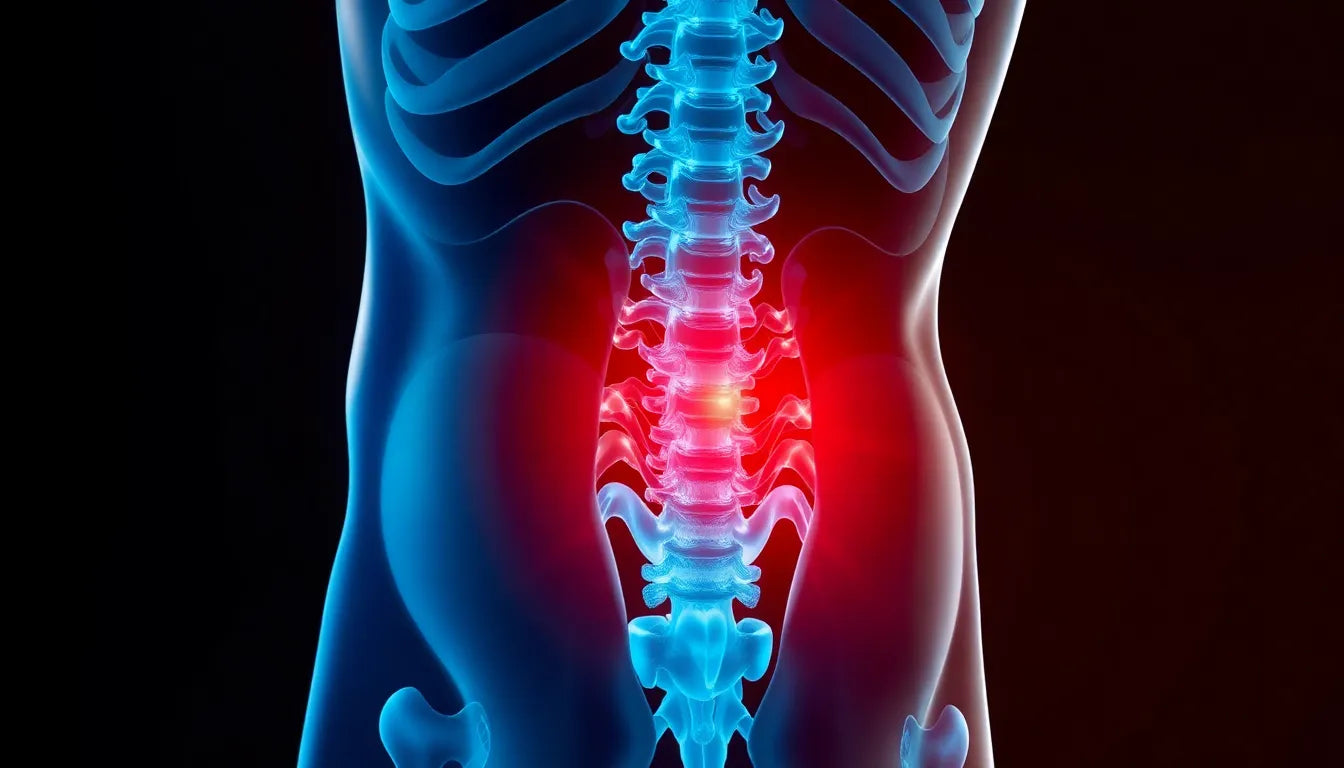Understanding the signs and symptoms of a herniated disc is crucial for maintaining spinal health and overall well-being. A herniated disc, also known as a slipped or ruptured disc, occurs when the soft inner gel of a spinal disc protrudes through a tear in its tougher exterior. This condition can significantly impact spinal health, leading to discomfort and impaired mobility. Early diagnosis plays a pivotal role in managing symptoms effectively and preventing further complications.
Why early diagnosis is crucial
Diagnosing a herniated disc early is essential for effective treatment and management. When left untreated, a herniated disc can lead to chronic pain, nerve damage, and even permanent disability. Early intervention allows for a wider range of treatment options, which can help alleviate pain and restore function. By identifying the issue promptly, individuals can take control of their health and avoid long-term consequences.
Common concerns about herniated discs
Many people seek information on how to diagnose a herniated disc due to persistent back pain, numbness, or tingling sensations that disrupt daily activities. These symptoms often prompt concerns about mobility and quality of life. Understanding the potential consequences of an untreated herniated disc, such as chronic pain and nerve damage, underscores the importance of seeking medical advice when symptoms arise.
Moreover, the fear of worsening symptoms or developing additional health issues motivates individuals to learn more about their condition. By gaining knowledge about the diagnostic process, individuals can approach their healthcare providers with informed questions and concerns, leading to a more proactive and engaged approach to their health care.
In conclusion, understanding how to diagnose a herniated disc is a vital step in taking control of one's health. By recognizing the signs and symptoms early, individuals can seek appropriate medical attention and explore treatment options that can prevent further complications. As we delve deeper into the specifics of herniated disc diagnosis, remember that knowledge is power, and taking action early can lead to better health outcomes.
Recognizing symptoms of a herniated disc
Identifying the symptoms of a herniated disc is a fundamental step in the diagnostic process. Common symptoms include numbness, tingling, and pain that typically radiates from the affected area of the spine to the limbs. For instance, a herniated disc in the lumbar region may cause discomfort in the lower back, buttocks, and legs, often referred to as sciatica. In contrast, if the herniated disc is located in the cervical spine, symptoms may manifest as pain or weakness in the shoulders, arms, and hands.
It's important to note that the severity and nature of symptoms can vary significantly depending on the disc's location and the extent of nerve involvement. Some individuals may experience sharp or burning pain, while others may notice a dull ache. Additionally, muscle weakness and decreased reflexes are common indicators that warrant further investigation by a healthcare professional.
Physical examination techniques for diagnosis
When diagnosing a herniated disc, healthcare providers often begin with a thorough physical examination. This initial assessment is crucial for identifying the presence of a herniated disc and determining the need for further diagnostic tests. During the examination, doctors typically perform a series of physical tests designed to evaluate nerve function and pinpoint the source of pain.
One such test is the straight leg raise test, which is particularly useful for detecting lumbar disc herniation. By gently lifting the patient's leg while they are lying down, the doctor can assess whether the movement triggers pain, indicating nerve root irritation. Another key component of the physical examination is the neurological check, which involves assessing reflexes, muscle strength, and sensory responses. These tests help identify any deficits that may be caused by nerve compression due to a herniated disc.
Diagnostic imaging: confirming the diagnosis
While physical examination techniques provide valuable insights, diagnostic imaging is often necessary to confirm a herniated disc diagnosis. Imaging techniques allow healthcare providers to visualize the spine and identify any abnormalities that may be causing symptoms. Among the various imaging methods, MRI (Magnetic Resonance Imaging) is considered the most effective tool for diagnosing herniated discs. MRI scans provide detailed images of soft tissues, including discs and nerves, enabling precise identification of herniation and its impact on surrounding structures.
In cases where MRI is not suitable or available, CT scans offer an alternative diagnostic option. CT scans provide detailed images of bone structures and can help identify any bony abnormalities that may contribute to disc herniation. Additionally, myelograms are sometimes used when MRI is contraindicated. This procedure involves injecting a contrast dye into the spinal canal, allowing for enhanced visualization of the spinal cord and nerves on X-rays or CT scans.
Each of these imaging methods has its advantages and limitations, and the choice of technique often depends on the individual's specific circumstances and the healthcare provider's clinical judgment. By combining physical examination findings with imaging results, doctors can make a definitive diagnosis and develop an appropriate treatment plan tailored to the patient's needs.
In conclusion, understanding the symptoms and diagnostic techniques for a herniated disc is essential for early detection and effective management. By recognizing the signs and seeking timely medical evaluation, individuals can take proactive steps to address their condition and prevent further complications. As we continue to explore advanced diagnostic approaches and preventive measures, remember that early intervention and informed decision-making are key to maintaining spinal health and overall well-being.
Advanced approaches in diagnosing herniated discs
As medical technology continues to evolve, new diagnostic approaches are being developed to improve the accuracy and comfort of diagnosing herniated discs. One such advancement is the use of ultrasound imaging, which offers a non-invasive and radiation-free method to assess soft tissue structures. While traditionally used for other medical purposes, its application in diagnosing herniated discs is gaining attention due to its potential to provide real-time imaging.
Another promising development is the integration of artificial intelligence (AI) in interpreting diagnostic images. AI algorithms can enhance the precision of identifying herniations by analyzing large datasets and recognizing patterns that may not be immediately apparent to the human eye. This technology not only aids in diagnosis but also helps in predicting outcomes and tailoring individualized treatment plans.
Integrating ergonomic solutions for prevention
In addition to advanced diagnostic methods, incorporating ergonomic solutions can play a significant role in managing symptoms and preventing further injury related to herniated discs. Ergonomic aids, such as supportive chairs and adjustable desks, help maintain proper posture, reducing strain on the spine. These tools are particularly beneficial for individuals who spend prolonged periods sitting or working at a computer.
Furthermore, lifestyle changes such as regular exercise, weight management, and core strengthening can significantly reduce the risk of disc herniation. Activities like yoga and pilates promote flexibility and strengthen the muscles that support the spine. By adopting these preventive measures, individuals can enhance their spinal health and minimize the likelihood of developing a herniated disc.
Frequently Asked Questions
What are the first signs of a herniated disc?
The initial signs of a herniated disc often include localized back pain and radiating pain in the limbs. This may be accompanied by numbness, tingling, or weakness in the affected areas, depending on the location of the herniation.
How long does it take to diagnose a herniated disc?
The timeline for diagnosing a herniated disc can vary. Typically, it involves an initial consultation with a healthcare provider, followed by physical examinations and diagnostic imaging, which may take a few weeks to complete.
Can a herniated disc heal on its own?
In some cases, a herniated disc can heal naturally over time with rest and conservative treatments such as physical therapy. However, medical guidance is crucial to ensure proper healing and prevent complications.
What lifestyle changes can help prevent herniated discs?
Preventive measures include maintaining good posture, using ergonomic furniture, engaging in regular exercise, and strengthening core muscles. These changes can help reduce the risk of disc herniation and promote overall spinal health.
When should I see a doctor for back pain?
It is advisable to see a doctor if you experience persistent back pain, numbness, or weakness in the limbs, especially if these symptoms interfere with daily activities. Early medical evaluation can help determine the underlying cause and guide appropriate treatment.
Sources
- Weill Cornell Neurological Surgery. "Diagnostic Imaging Techniques for Herniated Discs."
- American Academy of Family Physicians (AAFP). "Diagnosis and Treatment of Herniated Disc."
- WebMD. "Herniated Disc: Symptoms, Causes, and Diagnosis."
- Mount Sinai Hospital. "Understanding Herniated Discs: Diagnosis and Treatment."
- UCHealth. "Herniated Disc: Comprehensive Guide."


















